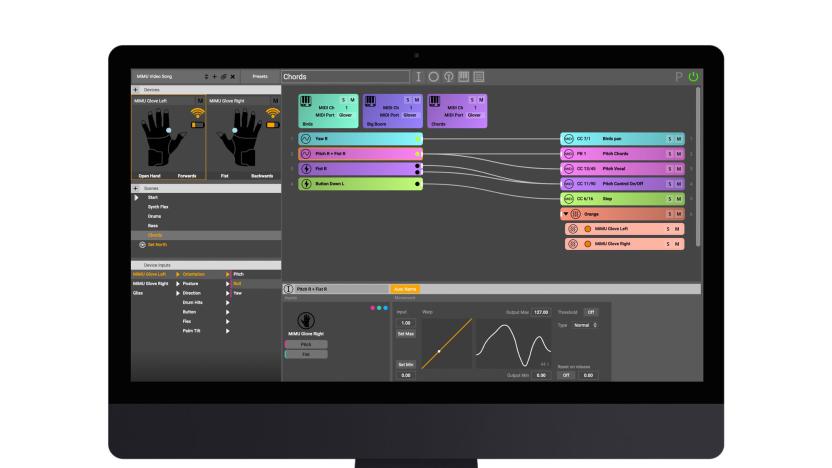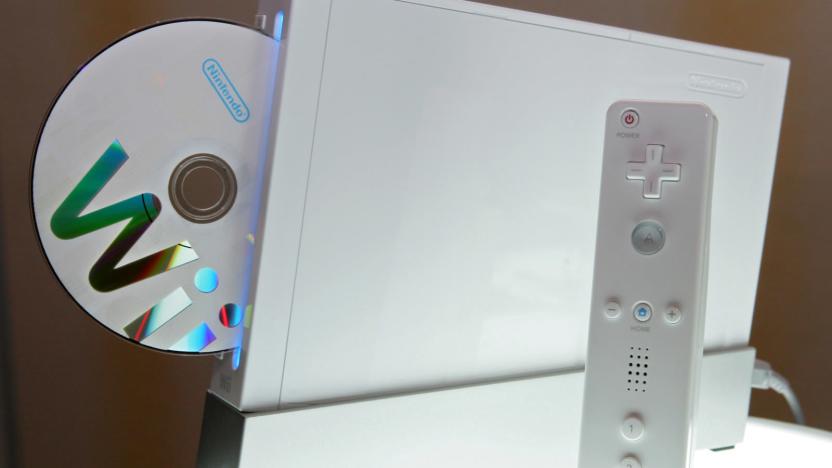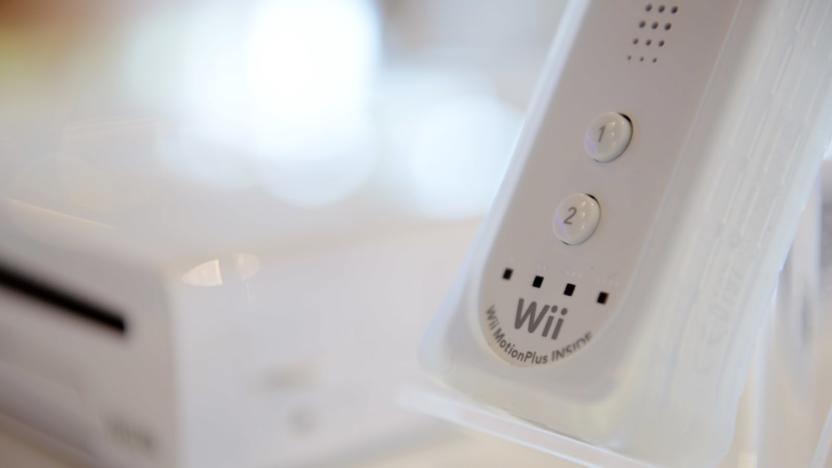motion sensing
Latest

WiZ's motion-sensing smart lights can now monitor your home
WiZ has unveiled a new home monitoring system that uses its existing motion-sensing WiFi smart bulbs in combination with Wiz's new $70 (€90) Indoor Camera.

You can now buy the software behind Imogen Heap's musical gloves
Glover was previously only available if you bought the Mi.Mu gloves.

Court overturns patent ruling that would've cost Nintendo $10 million
After almost seven years, Nintendo has won a patent case that involved the original Wii. On Tuesday, the company announced that a federal court in Dallas ruled in its favor against iLife Technologies, overturning an earlier 2017 decision that would have forced Nintendo to pay out $10.1 million in damages.

Linksys' Velop mesh routers can detect intruders using WiFi
If you want to improve your home security but would rather not add cameras or sensors to your living space, you could try using your router instead. Linksys has introduced a new motion sensing subscription service, Linksys Aware, which uses data from Velop mesh routers to monitor a home through WiFi signals.

Nintendo ordered to pay $10 million in Wii patent lawsuit
Today, a Dallas jury awarded iLife Technologies $10 million in its patent infringement lawsuit against Nintendo of America. The suit, which was brought forth in 2013, alleged that Nintendo used iLife's technology when creating its motion-sensing Wii Remote.

Motion-sensing 'PomPom Mirror' recreates your likeness in fur
If you're tired of your ugly mug staring back from across the bathroom sink every morning, just install this furry silhouetting mirror from New York-based artist Daniel Rozin. He built it for the Descent With Modification exhibit at NYC's bitforms gallery. The "PomPom Mirror," as it's called, leverages a Kinect motion capture device to control 464 servos that, in turn, flip 928 black and white faux fur pom poms back and forth to match your movements in real-time.

Report: Apple in talks to purchase co-creators of original Kinect tech
Apple is currently in talks to purchase PrimeSense, the original suppliers of Microsoft's Kinect motion-sensing technology, according to All Things D. The acquisition was first reported by Isreali publication Calcalist, which indicated that the purchase will amount to $345 million. Founded in 2005, PrimeSense contributed its 3D sensing technology to the Xbox 360 version of Kinect. Microsoft since went with in-house developers for the latest iteration of the Kinect for Xbox One, the company's latest console set to launch this Friday. Apple may be allegedly targeting PrimeSense for the company's Capri technology, a newer form of its 3D sensing tech used in mobile devices such as Google and Samsung's Nexus 10 tablets.

Attach more things to your head with Oculus Rift sensor, camera clips
Oculus Rift dev kits have been out in the wild for just under a month and the gameplay videos and mods keep trickling in. The latest mod comes for the hardware itself, two clips to add extra motion sensors or cameras to the back or front of the headset, both 3D-printed. Hackaday's Caleb Kraft designed and printed the attachments, one for extra, heavier sensors that threads through the flexible strap on the back of the Oculus Rift, and one that snaps right onto the front of the system, mainly for cameras."While browsing an Oculus Rift thread on Reddit, I saw someone mention how nice it would be to have some actual mounts for external sensors on their Rift," Kraft writes. "The idea is that adding additional sensors or cameras will allow us to expand the capabilities of the Rift."The Oculus Rift attachment designs are available for free for other 3D printing and VR headset aficionados via Makerbot's Thingiverse.

Caltech laser accelerometer research may bring fine-tuned position tracking, grocery ads
One way that sensors can track your position without using an array of satellites is by measuring your acceleration as you move around -- but unless you're piloting a jumbo jet, current devices aren't very accurate. Researchers at Caltech hope to change all that with a new, ultra-sensitive accelerometer they developed, which uses laser light to detect motion changes. The scientists managed to shrink a so-called large-scale interferometer down to micro-scale sizes, creating a device "thousands of times faster than the most sensitive sensors used today." That could allow a smartphone with such a micro-sensor to detect your exact position even while inside a grocery store, and flash "ads and coupons for hot dog buns" while you're in the bread aisle, according to Caltech. All that sounds good, but we can perhaps think of more inspiring uses for the new tech.

HBO GO teases vocal controls via Kinect, coming soon to Xbox 360 (video)
We knew it'd be arriving on April 1st, but now we're actually longing for it. HBO has just released a half-minute teaser propping up the impending release of HBO GO on Xbox 360, and while it's available on a plethora of other platforms, being able to verbally command HBO (through Kinect, of course) to play your favorite shows just takes the enticement up another level. Care to see for yourself? Tap that video just after the jump.

Naoki Maru's Real King Kizer gets closer to Real Steel with motion sensing (video)
Naoki Maru's Real King Kizer, the boxing robot to end all boxing robots, has been around for a hot minute, but the latest upgrade is bound to make even Wolverine Hugh Jackman take notice. The Real Steel-like setup was created when an Xtion Pro Live sensor (hint: it's like Kinect) was thrown into the equation. The 3-foot, 2-inch boxer was then allowed to reproduce the motions of Maru's kid, and unlike prior iterations, this one doesn't require a physical harness to transmit commands. Enough talk -- head on past the break to see the thing in action (but don't expect any commercialization details).

Sony makes a patent move for Kinect style controller
We're not suggesting Sony has a Kinect style controller coming soon, but it certainly filed a patent for one. The application for a "User-Driven Three-Dimensional Interactive Gaming Environment" was initially logged in October last year by Richard Marks of PlayStation Eye fame. The controller can "determine when to interact with the system by allowing part of the user's body, or an object, to cross the maximum depth range plane" meaning input could be limited to just the hands etc. This wouldn't be the first time Sony has created controller technology similar to its competitors, but the company is careful not to outright state that's what it's for. That said, amongst the legalese it does go as far too say the system can be implemented by an entertainment system "such as" its flagship console. So, sadly there's no way of knowing if we'll be getting a PlayStation Motion any time soon, but feel free to wave over the source link to see the patent for yourself.

Microsoft reportedly working on Kinect-enabled laptops
It remains to be seen when or if they'll turn into actual products, but The Daily reports that Microsoft is at least working on getting its Kinect technology shoved into laptops. While details are light, the iPad-based publication says that it's seen a pair of prototypes that "appear to be Asus netbooks running Windows 8," but which have had their webcams replaced with an array of sensors that run along the top of the screen (a set of LEDs are said to be at the bottom). The Daily also says that it's confirmed with a source at Microsoft that the devices are indeed official prototypes of a Kinect-enabled laptop, and it unsurprisingly suggests that Microsoft would likely license the technology to laptop manufacturers rather than build its own hardware.

Mosoro Bluetooth LE iOS accessories improve your golf, if the weather's right
So far the appcessories -- yeah we said it, APPcessories -- we've seen include some good ideas, and some less so. The Bluetooth LE 3D-Sport and Weather offerings from Mosoro fall into the former category (if they make their way into a shipping product that is). The 3D-Sport is a motion capture device you attach to sports equipment. The on-board accelerometer, gyroscope and magnetometer beam motion data to your iOS device, where it can be analyzed by Rocky-style Russian coaches to see where your throw or golf swing is going wrong. The latter is a mini weather station that reads temperature, humidity, elevation, and barometric pressure to tell you the conditions where you are right now. More usefully, it nabs your GPS location and uploads it all to Mosoro's aptly named "Cloud" Server that presumably maps out some crazy real-time crowdsourced weather report. Both also use Bluetooth 4.0's low energy technology so they won't need to see a charger for a long time. Now we just need a company that likes collating personal data, perhaps with a weather service, to snap this one up... any takers?

Microsoft's KinectFusion research project offers real-time 3D reconstruction, wild AR possibilities
It's a little shocking to think about the impact that Microsoft's Kinect camera has had on the gaming industry at large, let alone the 3D modeling industry. Here at SIGGRAPH 2011, we attended a KinectFusion research talk hosted by Microsoft, where a fascinating new look at real-time 3D reconstruction was detailed. To better appreciate what's happening here, we'd actually encourage you to hop back and have a gander at our hands-on with PrimeSense's raw motion sensing hardware from GDC 2010 -- for those who've forgotten, that very hardware was finally outed as the guts behind what consumers simply know as "Kinect." The breakthrough wasn't in how it allowed gamers to control common software titles sans a joystick -- the breakthrough was the price. The Kinect took 3D sensing to the mainstream, and moreover, allowed researchers to pick up a commodity product and go absolutely nuts. Turns out, that's precisely what a smattering of highly intelligent blokes in the UK have done, and they've built a new method for reconstructing 3D scenes (read: real-life) in real-time by using a simple Xbox 360 peripheral. The actual technobabble ran deep -- not shocking given the academic nature of the conference -- but the demos shown were nothing short of jaw-dropping. There's no question that this methodology could be used to spark the next generation of gaming interaction and augmented reality, taking a user's surroundings and making it a live part of the experience. Moreover, game design could be significantly impacted, with live scenes able to be acted out and stored in real-time rather than having to build something frame by frame within an application. According to the presenter, the tech that's been created here can "extract surface geometry in real-time," right down to the millimeter level. Of course, the Kinect's camera and abilities are relatively limited when it comes to resolution; you won't be building 1080p scenes with a $150 camera, but as CPUs and GPUs become more powerful, there's nothing stopping this from scaling with the future. Have a peek at the links below if you're interested in diving deeper -- don't be shocked if you can't find the exit, though. %Gallery-130263%

KinectNUI enables Minority Report style interaction in Windows sans gloves (video)
When Microsoft released its Kinect SDK we marveled at the impact it could have on desktop interaction; sure enough, Kevin Connolly's Kinect Natural User Interface has made our geeky pipe-dreams a reality. His inspiration for project? Not surprisingly, the Minority Report UI (aka g-speak). Similar projects like MIT's hack do exist, but it's brilliant knowing that another emulation has been made rather quickly with Redmond's tools. In a brief video using the Kinect on Windows 7, he demos various ways of manipulating on-screen content with hand gestures and body tracking -- neglecting his mouse in the process. It's still a work in progress, but the results are already quite striking, so take that ancient input device and click past the break for the full demo.

Kudo Tsunoda doesn't tell us a thing about Windows 8 support for Kinect
Microsoft asked us to drop by at E3 to chat up a generically identified "Xbox executive," imagine our surprise when we found Kudo Tsunoda hiding behind door number six. Wearing his signature shades, Kudo gave us a brief primer on what makes Kinect great, or at least a heavy endorsement of Kinect Fun Labs. While we can certainly dig the bite-sized gadgetry Fun Labs has to offer, we like to dig deeper -- will the Kinect hardware ever be integrated into other devices? Any plans for Microsoft's 3D tracking camera and Windows 8? Kudo did his best to feed our ravenous appetite for answers. It wasn't easy on poor Kudo, of course -- more than once we saw him glance longingly at his wrangler, a friendly PR rep keeping him from spilling the beans on anything too awesome. Probing about Windows 8 and Kinect produced one such look, and while our man very lightly suggested that Microsoft does more than games -- and that the dual-camera device might start showing up on other devices -- the big M had nothing to announce at that time. Kudo did go on to say, however, that we can expect to see new, innovative, "oh my gosh, I can't believe Kinect can do that" experiences at E3 year after year, citing this year's keynote for some recent examples. While we couldn't coax any leaks about Xbox or Kinect successors out of the man, it's good to see Microsoft's continued dedication to improving the platform.

Aiken Labs brings 9-axis modular motion sensing to Android, we go hands-on (video)
We already had a chance to try out Immersive Motion from Aiken Labs at CES, but now the nine-axis modular sensing system is making its way to Android and other mobile platforms, including iOS and Windows Phone. The more compact battery-powered server brings motion-controlled gaming to mobile environments, capturing position data from matchbox-size modular sensors that you can tape to a wooden sword or Viking helmet for live-action outdoor role-playing, or on you paws and dome during a virtual jam session with friends, for example. The mobile kit includes a pair of wireless sensors with a 50-foot range that you can attach to literally any accessory or appendage, and is expected to sell for about $300 when it ships later this year. You'll also be able to connect up to two smaller wired sensors to each wireless sensor, for about $50 a pop. The kit's price tag makes it cost-prohibitive for all but the most hardcore gamers and devs (there's an SDK available as well), but Aiken hopes to make its flagship product more affordable if its able to sell the kits in high volume. The tool has applications in other industries as well, including research and Hollywood, where it could be used as a (relatively) low-cost outdoor motion-capture suit. The early version we saw at E3 today is definitely not ready to head to production, but we're still months away from an actual release, giving Aiken some time to improve accuracy, and perhaps find a way to reduce that price. Jump past the break to see how it works.%Gallery-125868% Tim Stevens contributed to this report.

Kinect Star Wars hands-on: Engadget and Joystiq get in touch with the Force
We've been waiting for nearly an entire year to carve up battle droids with a Kinect-controlled lightsaber, and we got the chance last night, donning virtual Jedi robes alongside our friends at Joystiq and calling upon our inner midi-chlorians in a series of brief co-op fights. The interactive demo of Kinect Star Wars version is a fairly scripted affair -- your light side avatars automatically dash from encounter to encounter with the occasional cutscene between, without any prompting from you, and when you get into a melee, the computer controls which enemies you face as well. Still, there are quite a few maneuvers available once combat begins in earnest. You can swing your right hand to swipe with the lightsaber, bring up your left for a powerful Force Push, jump to flip over hapless destroyer droids, step forward to dash directly at a foe, and tilt your body to dodge and flip. There's a bit of a delay between the time you gesture and the time the game recognizes your actions, but it generally seemed to follow our saber strokes, and a product manager tells us a lag fix is inbound. Long story short, we can't tell you quite yet if your 1:1 slicing fantasies will be fulfilled.

Pentax releases O-GPS1 add-on for DSLRs, appeals to astronomy nuts
Pentax's Optio WG-1 GPS point-and-shoot satisfied geotaggers out of the box, but owners of its K-5, K-r and 645D DSLRs have had to make do with third-party taggers like the PhotoTrackr or Eye-Fi. The new hotshoe-mounted O-GPS1 module fixes that oversight by recording latitude, longitude, altitude, Coordinated Universal Time and shooting angle. Everyday snappers might find an extra hotshoe attachment cumbersome, but astro-photography enthusiasts could well be enticed by the device's interesting "ASTROTRACER" function. This helps you take clearer photos of celestial bodies by using the in-built sensors to calculate a star's movement and then employing the camera's shake reduction system to compensate. Sounds clever, but be advised: this module is only for Pentax DSLRs -- and only for very specific models at that. You'll get full functionality with the K-5 and K-r cameras, and geotagging (no ASTROTRACER) with the 645D. Oh, and you'll need to make sure your camera's firmware is up-to-date. Peer carefully through that lens and you'll see the O-GPS1 heading for a July landing, priced at $250. [Thanks, Iddo]














